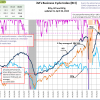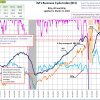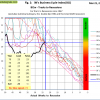The Previous Updates
April 4, 2024
March 21, 2024
April 5, 2024
Stock-markets:
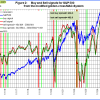 The MAC-US model invested the US stock markets in first week of February 2023.
The MAC-US model invested the US stock markets in first week of February 2023.
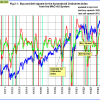 The MAC-AU model generated a buy signal end November 2023, and is invested from the Australian stock market.
The MAC-AU model generated a buy signal end November 2023, and is invested from the Australian stock market.
This model and its application is described in MAC-Australia: A Moving Average Crossover System for Superannuation Asset Allocations.
Recession:
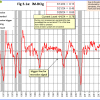 BCIg is not signaling a recession.
BCIg is not signaling a recession.
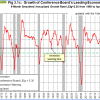 The growth of the Conference Board’s Leading Economic Indicator does not signal a recession.
The growth of the Conference Board’s Leading Economic Indicator does not signal a recession.
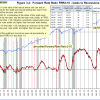 The Forward Rate Ratio between the 2-year and 10-year U.S. Treasury yields (FRR2-10) inverted beginning August 2022 and is signalling a recession — the average lead time of this signal is 14 months.
The Forward Rate Ratio between the 2-year and 10-year U.S. Treasury yields (FRR2-10) inverted beginning August 2022 and is signalling a recession — the average lead time of this signal is 14 months.
A description of this indicator can be found here.
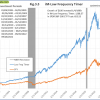 The iM-Low Frequency Timer switched to bonds on 9/26/2022.
The iM-Low Frequency Timer switched to bonds on 9/26/2022.
A description of this indicator can be found here.
March 22, 2024
Market Signals Summary:
The S&P 500 Coppock Indicator exited the markets mid January 2024. All other indicators, that is the MAC-US, the 3-mo Hi-Lo Index of the S&P 500, the CAPE-Cycle-ID, and the iM-Google Trend Time are invested in the stock market. The BCIg does not signal a recession as does the growth of the Conference Board’s Leading Economic Indicator. The Forward Rate Ratio between the 2 and 10 year rates inverted beginning August 2022; November 2022. The iM-Gold Coppock and the iM-Silver Coppock are invested in the respective metals, as is the iM-Gold Timer.
Stock-markets:
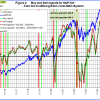 The MAC-US model invested the US stock markets in first week of February 2023.
The MAC-US model invested the US stock markets in first week of February 2023.
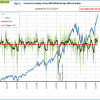 The 3-mo Hi-Lo Index Index of the S&P500 is at 13.47% (last week 13.28%) is invested in the markets the markets since mid December 2023..
The 3-mo Hi-Lo Index Index of the S&P500 is at 13.47% (last week 13.28%) is invested in the markets the markets since mid December 2023..
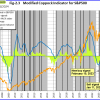 The Coppock indicator for the S&P500 exited the the US stock markets mid January 2024. This indicator is described here.
The Coppock indicator for the S&P500 exited the the US stock markets mid January 2024. This indicator is described here.
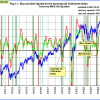 The MAC-AU model generated a buy signal end November 2023, and is invested from the Australian stock market.
The MAC-AU model generated a buy signal end November 2023, and is invested from the Australian stock market.
This model and its application is described in MAC-Australia: A Moving Average Crossover System for Superannuation Asset Allocations.
Recession:
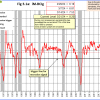 BCIg is not signaling a recession.
BCIg is not signaling a recession.
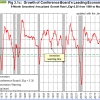 The growth of the Conference Board’s Leading Economic Indicator does not signal a recession.
The growth of the Conference Board’s Leading Economic Indicator does not signal a recession.
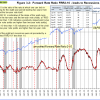 The Forward Rate Ratio between the 2-year and 10-year U.S. Treasury yields (FRR2-10) inverted beginning August 2022 and is signalling a recession — the average lead time of this signal is 14 months.
The Forward Rate Ratio between the 2-year and 10-year U.S. Treasury yields (FRR2-10) inverted beginning August 2022 and is signalling a recession — the average lead time of this signal is 14 months.
A description of this indicator can be found here.
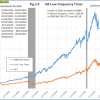 The iM-Low Frequency Timer switched to bonds on 9/26/2022.
The iM-Low Frequency Timer switched to bonds on 9/26/2022.
A description of this indicator can be found here.
Monthly Updates
March 8, 2024
Unemployment
 The 3/8/2024 BLS Employment Situation Report shows that the February 2024 unemployment rate remains unchanged at 3.9%. Our UER model does not signal a recession.
The 3/8/2024 BLS Employment Situation Report shows that the February 2024 unemployment rate remains unchanged at 3.9%. Our UER model does not signal a recession.
CAPE-Cycle-ID
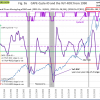 Fig 9a depicts the CAPE-Cycle-ID and the year-on-year rate-of-change of the Shiller CAPE; the level switched from -2 to 0 end of June 2023 generating a buy signal. This indicator now invested in the markets. This indicator is described here.
Fig 9a depicts the CAPE-Cycle-ID and the year-on-year rate-of-change of the Shiller CAPE; the level switched from -2 to 0 end of June 2023 generating a buy signal. This indicator now invested in the markets. This indicator is described here.
To avoid the bear market, exit stocks when the spread between the 5-month and 25-month moving averages of S&P-real becomes negative and simultaneously the CAPE-Cycle-ID score is 0 or -2. (read more)
Estimated Forward 10-Year Returns
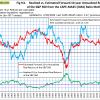 The estimated forward 10‐year annualized real return is 5.8% (previous month 6.1%) with a 95% confidence interval 4.4% to 7.2% (4.6% to 7.5% ). Also refer to the Realized Forward 10-Year Returns vs. Inflation Rate
The estimated forward 10‐year annualized real return is 5.8% (previous month 6.1%) with a 95% confidence interval 4.4% to 7.2% (4.6% to 7.5% ). Also refer to the Realized Forward 10-Year Returns vs. Inflation Rate 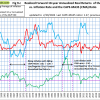 We may be in a rising inflation period with a falling CAPE-MA35 ratio similar to 1964-1973. This implies very low or negative 10 year forward annualized real returns, much lower than the returns indicated by regression analysis shown in the Estimated Forward 10-Year Returns.
We may be in a rising inflation period with a falling CAPE-MA35 ratio similar to 1964-1973. This implies very low or negative 10 year forward annualized real returns, much lower than the returns indicated by regression analysis shown in the Estimated Forward 10-Year Returns.
.
iM-GT Timer
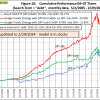 The iM-GT Timer, based on Google Search Trends volume indicator entered the stock markets beginning September 2023. This indicator is described here.
The iM-GT Timer, based on Google Search Trends volume indicator entered the stock markets beginning September 2023. This indicator is described here.
Trade Weighted USD
 Will be updated later, the weekly FRED data series we used was discontinued and replacement series is daily and runs from 2015. We need to adapt our software and graphics first.
Will be updated later, the weekly FRED data series we used was discontinued and replacement series is daily and runs from 2015. We need to adapt our software and graphics first.
TIAA Real Estate Account
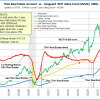 The 1-year rolling return is -14.4% (previous month -15.1%) and generated a sell signal begin April 2023.
The 1-year rolling return is -14.4% (previous month -15.1%) and generated a sell signal begin April 2023.

